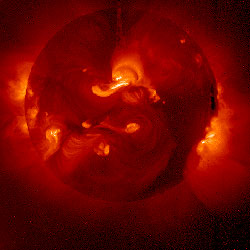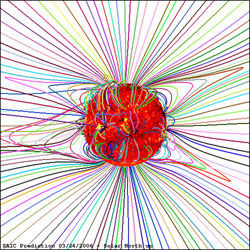The surface of the sun is 5770 K, but the corona is 1.7 million K... what's up with that?
ISSUE #58: WHY IS THE SUN'S CORONA SO HOT?

Figure 1: This 1991 photograph captures the brief moment of totality when the Sunís faint corona is most easily observed. It is made up of several photographs from cameras with different settings that were later combined into one image. Credit: Steve Albers, Dennis di Cicco, ad Gary Emerson.
Statement of the Problem:
The core of the sun has a temperature of 15.7 million K and this temperature decreases steadily to the solar surface (the photosphere) where it reaches 5,770 K. But then, it starts to increase again as we enter the outer atmosphere of the sun (the corona) where it can reach nearly 2 million K. What processes are making the temperature rise in the corona, instead of continuing to fall to the temperature of empty space (2.7 K)?
History:
The temperature of the sun's photosphere was first determined by Joseph Stephan (1835-1893) in 1884 and determined a value of 5,430 K, by using a relationship between the temperature of a 'black body' and its color. Meanwhile, instruments called spectroscopes had been used during this time to catalog the many different atomic 'lines' in the solar spectrum. The majority of these lines came from elements heated to temperatures not much different than the photospheric temperature. But during the early years of solar spectroscopy, as instruments improved in sensitivity, many additional, mysterious, atomic lines were also discovered. Some of these were called 'Coronium' because they were only found in the solar corona during total solar eclipses.

Figure 2: This image of the corona was taken with the Yohkoh Soft X-Ray Telescope and shows the complex, hot plasmas that make up the corona (Courtesy: Yohkoh)
In 1942, the Swedish astronomer Bengt Edlen (1906-1993) was able to show that many of these coronium lines actually came from ordinary atoms of iron but where the iron atoms had lost many of their electrons through ionization. Normally, iron has 26 electrons, but Edlin showed that some of the coronium lines came from iron atoms that had lost as many as 13 of their electrons... an ion that solar physicists would later designate Fe XIV. For this ground-breaking work, Bengt Edlen received The Gold Metal of Royal Astronomical Society in 1945 for solving the Coronium mystery. Meanwhile, the solution of one mystery led to another.
The more electrons you remove from an atom, the more energy you have to expend. Normally, this energy comes from the collisions between the atoms at high speeds and temperatures. When the Fe XIV ions were used by Edlen as a solar thermometer, he deduced that they have to be subjected to temperatures over 1 million K. No one could fathom how it was that such high-temperatures could be sustained so far above the surface of the much cooler (5,770K) solar surface. It would be like standing in your kitchen far away from the open oven, but feeling temperatures almost 100 times higher than what was inside the oven!
Explanations:
Sound Waves!
When you crack a whip, you are adding energy to the fat base of the whip with a wave pulse. This wave pulse travels down the tapering whip causing the whip to move faster and faster until it moves at the speed of sound. Energy is conserved along the way, but the speed of the particles increases as you get farther from the base of the whip.
In 1949 astronomer Evry Schatzman proposed the Wave Heating Theory. The idea was that the sun generated two types of waves because it was a turbulent ball of plasma laced with magnetic fields. The first kind are called Alfven Waves, and represent ripples carried along magnetic field lines. The second is called magneto-acoustic waves, which are a combination of pressure waves (sound waves) but modified by the presence of magnetic fields. Because the density of the gas in the corona drops quickly, magneto-acoustic waves cannot carry enough energy into the corona fast enough to heat the gases. They also tend to be reflected back into the photosphere. In 1997, the SOHO satellite observed magneto-acoustic waves on the sun, and showed that they only carry about 10% of the energy needed to heat the corona.
Meanwhile, Alfven waves carry quite a bit of organized energy, but physicists could not find an efficient way to convert (dissipate) this into heating coronal gases. In 2007, the first actual detection of Alfven waves in the solar corona was carried out by Steve Tomczyk of the National Center for Atmospheric Research (NCAR), and Scott McIntosh of the Southwest Research Institute. They used an instrument developed at NCAR called the Coronal Multichannel Polarimeter, or CoMP, which uses a telescope at the National Solar Observatory in Sacramento Peak, New Mexico. They found waves traveling through the corona at speeds of 2,500 km/sec. Research is continuing to determine whether they carry enough energy to account for coronal heating.

Figure 3: A recent computer model of the sun's magnetic fields in the corona. (Courtesy - Stanford Solar Center)
Magnetic Reconnection.
Magnetic fields can store energy. When plasmas laced with magnetic fields 'do work' to twist and tangle a magnetic field, some of that energy is stored in the magnetic field, and can be released when the fields 'reconnect' into simpler shapes. This is believed to be the energy source for solar flares. Observations by the SOHO satellite revealed that the sun is covered by a 'magnetic carpet' of small weak magnetic fields which are constantly being re-arranged by the convection of the solar surface.
Observations by SOHO, RHESSI and other satellites over the years, have found that the solar surface is also dappled by solar flares at scales from the occasional, giant events, to small nano-flares only a few hundred kilometers across - similar to the scale of the magnetic carpet fields. The large solar flares are spectacular, but common only during sunspot maximum. Since the corona is hot all through the sunspot cycle, large flares cannot be the dominant cause of the sustained coronal temperatures. However, it is possible that the around-the-clock action of thousands of micro and nano-flares erupting hundreds of times an hour may be able to heat the corona using the magnetic energy released by these numerous, but hard-to-see flares.
All Together Now...
A further possibility is that the corona is heated by many different processes, each contributing its own share of the heating. Perhaps when magneto-acoustic waves, Alfven waves and micro-flare reconnection are added together, they will add up to 100% and solve the mystery!
GALLERY
REFERENCES
Aschwanden, M. J. (2004). Physics of the Solar Corona. An Introduction. Praxis Publishing Ltd.. ISBN 3-540-22321-5.
"Alfven Waves in the Solar Corona" S. Tomczyk, S.W. McIntosh, S.L. Keil, P.G. Judge, T. Schad, D.H. Seeley, J. Edmondson, Science, August 31, 2007
2008 ISSUES
- #63: Eclipse
- #62: Where is the heliopause?
- #61: What causes and Auroral Storm?
- #60: Where does the Sun's magnetic field come from?
- #59: Where did all the Neutrinos go?
- #58: Why is the Sun's Corona Hot?
View past issues
Space Weather Fact
A major solar 'superstorm' such as the one in 1859 could cost $30 billion a day to the US electrical power grid, and up to $70 billion to the satellite industry.




